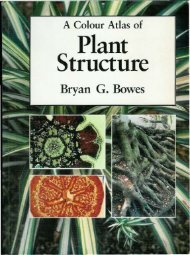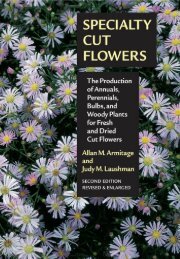Create successful ePaper yourself
Turn your PDF publications into a flip-book with our unique Google optimized e-Paper software.
alkaloidreleased causes the dough to rise). Duringalcoholic fermentation acetaldehyde actsas a hydrogen acceptor instead <strong>of</strong> oxygen.<strong>The</strong> pyruvic acid formed by GLYCOLYSIS isbroken down into acetaldehyde and carbondioxide. <strong>The</strong> acetaldehyde is furtherreduced by NADH to form ethanal, releasingonly about a tenth <strong>of</strong> the energy thatwould be released by aerobic respiration.aldehyde A type <strong>of</strong> organic compoundwith the general formula RCHO, wherethe –CHO group (the aldehyde group) consists<strong>of</strong> a carbonyl group attached to a hydrogenatom. Simple examples <strong>of</strong>Aldosealdehydes are methanal (formaldehyde,HCHO) and ethanal (acetaldehyde,CH 3 CHO).aldose A SUGAR containing an aldehyde(CHO) or potential aldehyde group. Examplesinclude the sugars ribose (with fivecarbon atoms) and glucose (with six carbonatoms).aleurone grain (aleurone body) A modifiedvacuole found in the embryo and endosperm<strong>of</strong> seeds and containing mostlyreserve proteins, but also phytic acid andvarious enzymes associated with mobilization(digestion) <strong>of</strong> these reserves. <strong>The</strong> proteinsand phytic acid are present incrystalline form in the dormant seed.aleurone layer <strong>The</strong> outermost proteinrichlayer <strong>of</strong> the endosperm <strong>of</strong> grass fruits(e.g. cereal grains). At germination, the embryoproduces gibberellin, which stimulatesthe aleurone layer to synthesizeenzymes, especially amylase. <strong>The</strong> lattercauses hydrolysis <strong>of</strong> the starch in the endosperm.<strong>The</strong> enzymes are synthesizedfrom the amino acids supplied by breakdown<strong>of</strong> ALEURONE GRAINs.algae (sing. alga) A large mixed group <strong>of</strong>photosynthesizing eukaryotic organisms,now usually placed in the kingdom Protoctista.<strong>The</strong>y <strong>of</strong>ten resemble plants and arefound mainly in marine or fresh-waterhabitats, although some algae are terrestrial.Algae differ from plants in lackingany real differentiation <strong>of</strong> leaves, stems,and roots, in having no layer <strong>of</strong> sterile cellsaround the reproductive organs,and in nothaving an embryo stage in their life cycle.Algae can be unicellular (e.g. Chlamydomonas),colonial (e.g. Volvox), filamentous(e.g. Spirogyra), or thalloid (e.g.Fucus). All algae contain chlorophyll butthis may be masked by various accessorypigments, these being one <strong>of</strong> the majorcharacteristics used to divide the algaeinto their various phyla. Other charactersused to classify the algae are the nature<strong>of</strong> storage products, the type <strong>of</strong> cell wall,the form and number <strong>of</strong> undulipodia(flagella), ultrastructural cell details, type<strong>of</strong> food reserves, and reproductive processes.alkaline soilalkaloidSee calcareous soil.<strong>On</strong>e <strong>of</strong> a group <strong>of</strong> organic com-9





